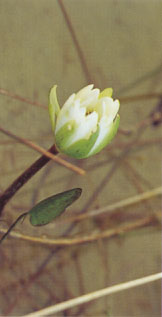
|
|
| Nymphaea caerulea - Water Lily / Blue Lotus - Nymphaeaceae - Temperate and warm zones worldwide |
|
Nymphaea caerulea, (Blue Lotus) is often confused with Agapanthus africanus (Blue Lily). Though the two plants look nothing alike (aside from being blue), both Nymphaea caerulea and Agapanthus africanus are sometimes referred to as the “blue lily”. “Blue lily” seems to be a more accurate name for Agapanthus africanus. Nymphaea caerulea is more commonly called the “blue lotus” or “blue water lily”. It is Nymphaea caerulea (blue lotus) which was used in ancient Egypt as a key to good health, sex, and re-birth. An aphrodisiac for both men and women as well as a general remedy for all illness. Enhancing sexual vigor and general good health. A tonic like ginseng, pain reliever like Creating a feeling of well being, euphoria and ecstasy, Nymphaea caerulea (blue lotus) is a water plant growing on the shores of lakes and rivers. Agapanthus africanus (blue lily) is a drought tolerant plant, which is commonly used as a landscaping plant in the U.S. IDENTIFICATION: Represented in ancient Egyptian art. The blue lotus was found scattered over Tutankhamen’s body when the Pharaoh’s tomb was opened in 1922. Many historians thought it was a purely symbolic flower, but there may be some reason to believe that ancient Egyptians used it to induce an ecstatic state, stimulation, and/or hallucinations, as well as being widely used as a general remedy against illness, and to this day is used as a tonic for good health, consumed as an extract, 6-12 drops or up to 1 tsp to 1 ACTIVE CONSTITUENTS: Rumored to contain apomorphine - a dopamine agonist - as well as perhaps nuciferine. Were unfounded when in 2000 at Dr. Vic Garner’s laboratory for forensic analysis in Manchester, England, the Egyptian mummy Azru was the first mummy to undergo mass spectroscopy. She had no narcotics or painkillers in her. They found phytosterols, bioflavonoids, and phosphodiastrates, the active ingredient of viagra, all from blue lotus. No drug use has ever been found in ancient Egypt. Azru, is an Egyptian mummy donated to the Manchester Museum in England, in 1825. Living on the Nile, in 2700 B.C, Azru was royalty, a noblewoman of Thebes, later called Luxor, a former capital of Egypt, a chantress at Khonsu - the moon god was the son of Amon and Mut. The main temple at Karnak is dedicated to him. Three times a day she would bring food and wine with blue lotus tincture or extract, fetch arments for the gods, priests and Pharaoh, and dance and sing for the royal court. She had wealth, and her own home and servants, where she stayed until scheduled or called to the temple. There is evidence to suggest that it was a very sexually oriented society due to their pictures, writings, and religous beliefs. And, that blue lotus was historically, traditionally and effectively used, to relieve pain, increase memory, increase circulation, promote sexual desire and create a feeling of euphoria and ecstacy, without the use of narcotics.
TRADITIONAL PREPARATION: Fresh Nymphaea Caerulea (Blue Lotus) was made into a tea or drank after being soaked in wine, usually followed by a cigarette made of the dried plant material. Details are speculative and difficult to come by, as this is another plant that need smore research done in regard to it. |
|
Related
Articles :
|
|
| Email
This Article To A Friend - Print
This Article Articles can be E-mailed to a friend and you can get a printable version of the article. Use your own buttons and links! |
|
